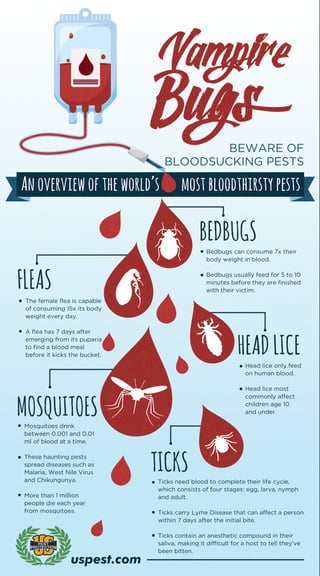Report
Share
Download to read offline

Recommended
More Related Content
What's hot
What's hot (20)
Fighting Global Disease and Degradation of Health Caused by Mosquitoes throug...

Fighting Global Disease and Degradation of Health Caused by Mosquitoes throug...
Important Zoonotic disease and its prevention and control By: Dr.Manoj karki

Important Zoonotic disease and its prevention and control By: Dr.Manoj karki
Rabies its transmission, clinical features and prevention

Rabies its transmission, clinical features and prevention
Viewers also liked (6)
340B Discount Drug Program: Updates and Changes Affecting Contract Pharmacies�

340B Discount Drug Program: Updates and Changes Affecting Contract Pharmacies�
Similar to Vampire bugs-infographic-e
Similar to Vampire bugs-infographic-e (20)
Vampire bugs-infographic-e
- 1. BEWARE OF BLOODSUCKING PESTS An overview of the world’s most bloodthirsty pests BEDBUGS Bedbugs can consume 7x their body weight in blood. Bedbugs usually feed for 5 to 10 minutes before they are finished with their victim. FLEAS The female flea is capable of consuming 15x its body weight every day. A flea has 7 days after emerging from its puparia to find a blood meal before it kicks the bucket. MOSQUITOES Mosquitoes drink between 0.001 and 0.01 ml of blood at a time. These haunting pests spread diseases such as Malaria, West Nile Virus and Chikungunya. More than 1 million people die each year from mosquitoes. HEAD LICE Head lice only feed on human blood. Head lice most commonly affect children age 10 and under. TICKS Ticks need blood to complete their life cycle, which consists of four stages: egg, larva, nymph and adult. Ticks carry Lyme Disease that can affect a person within 7 days after the initial bite. Ticks contain an anesthetic compound in their saliva, making it difficult for a host to tell they've been bitten. uspest.com
